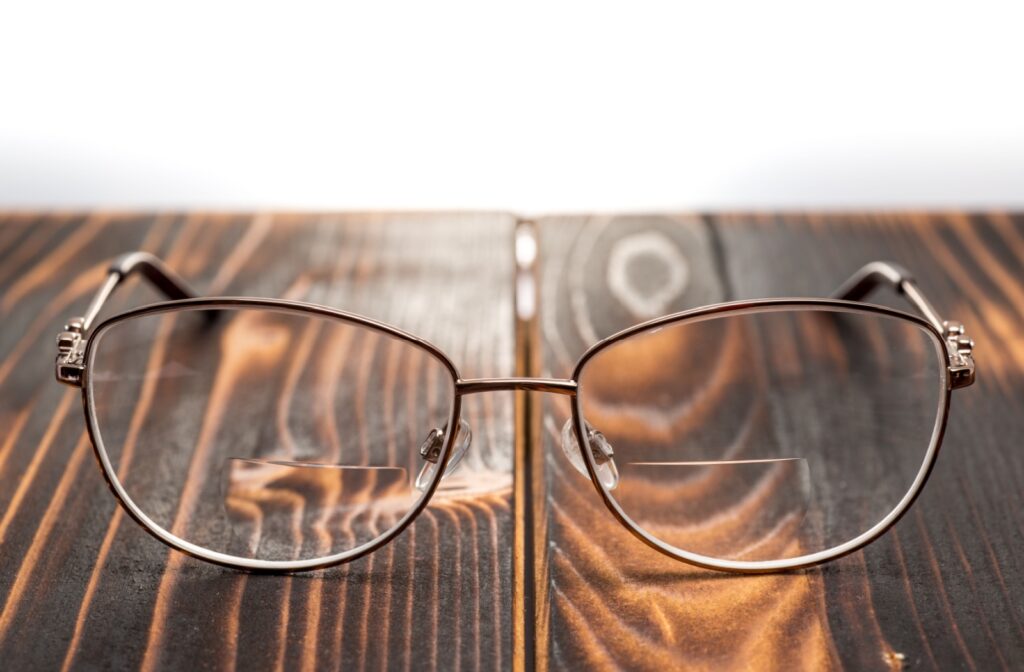As you get older, you may experience natural vision changes. For instance, it may become harder to read small print or see things up close. This common condition, called presbyopia, often leads people to explore multifocal glasses.
Two popular choices for presbyopia are bifocals and progressives. The main difference is that bifocals have two distinct viewing zones, with a visible line between them, while progressives offer a seamless transition between multiple zones, including distance, intermediate, and near vision, without any lines.
What Causes the Need for Multifocal Lenses?
The need for different lens powers often comes from natural changes in your eyes that happen over time. It’s a normal part of the aging process for many adults.
A Look at Presbyopia
Presbyopia is an age-related condition that makes it more difficult to see things up close. As we age, the lenses of our eyes become less flexible, which impacts their ability to focus on nearby text or objects. This is why many people in their 40s and beyond start holding menus or their phones farther away to see them clearly.
A Closer Look at Bifocal Glasses
Bifocals have been a straightforward vision solution for many years. They correct your vision for two different distances with one lens. This design is simple and often effective.
How Do Bifocals Work?
Bifocal lenses contain two distinct prescriptions. The top part of the lens is typically for distance vision, while a smaller segment at the bottom is for near vision, like reading. A visible line separates these two zones.
Advantages of Bifocals
- Clear Vision Zones: You get two distinct fields of vision for distance and near tasks. without blurriness in those specific areas.
- Budget-Friendly: Bifocals are often a more affordable option compared to other multifocal lenses.
Disadvantages of Bifocals
- Visible Line: The line separating the two prescriptions can be noticeable to you and others.
- Image Jump: Some people experience a disorienting “jump” as their eyes move across the line from one zone to another.
- No Intermediate Vision: Bifocals lack a dedicated zone for intermediate distances, which can be a challenge for computer use.

Explore Progressive Lenses
Progressive lenses, often called no-line bifocals, offer a modern approach to multifocal vision correction. They provide a seamless look and a more gradual transition between prescription powers. This gives you a wider range of focus in one pair of glasses.
How Do Progressives Work?
Progressive lenses have three main viewing zones that blend into one another without any visible lines. The top zone is for distance, the middle one is for intermediate vision, and the bottom one is for near vision. You simply adjust your head position to look through the part of the lens that you need.
Advantages of Progressive Lenses
- Smooth Transitions: The gradual change in lens power allows for a more natural flow between distance, intermediate, and near vision.
- No Visible Lines: Many people find the absence of visible lines to be more visually appealing.
- Versatile for Everyday Use: They are useful for a wide range of activities, from driving to computer work to reading a book, which supports your overall eye health.
Potential Drawbacks of Progressive Lenses
- Adaptation Period: It can take from a few days to a few weeks to get used to the different zones.
- Cost: Progressive lenses are generally more expensive than traditional bifocals.
How to Choose the Right Lenses for Your Lifestyle
The choice between bifocals and progressives often comes down to your daily activities, personal preference, and budget. Thinking about your vision needs can help you and your eye doctor decide on a good solution. Your lifestyle plays a large part in determining which option will work for you.
When Bifocals Might Be a Good Fit
If you primarily need help with distance and near tasks and prefer distinct viewing zones, bifocals can be an effective and economical choice. They work well for people who aren’t bothered by the visible line. They’re also a good fit if you don’t use a computer for long periods.
Who Benefits from Progressive Lenses?
Progressives are a good option if you want a seamless, no-line look and need clear vision at all distances. They’re also particularly helpful if you spend a lot of time on the computer or have hobbies that require intermediate vision. They can provide a single pair of glasses for all your daily activities.
Are Bifocals & Progressives Safe for Driving?
Both lens types can be used for driving, as long as your prescription meets your state’s required vision standards for driving. With bifocals, you use the top part of the lens to see the road ahead clearly. With progressives, you do the same, but you also have the ability to glance down at your dashboard with a clear view through the intermediate zone.
Tips to Adapt to Your New Glasses
Adjusting to new multifocal lenses takes time. Your brain and eyes need a little while to learn how to use the different viewing zones correctly, a process that relies on your brain’s ability to adapt. A little patience and practice can make the transition smooth.
Try to wear your new glasses as much as possible for the first one to two weeks. Switching back and forth between your new and old glasses can make the adjustment period longer. Consistent wear helps your brain adapt more quickly.
When to Talk to Your Eye Doctor
If you’re still having trouble after a few weeks, it’s a good idea to check in with your optometrist. Our eye doctors in Fountain Valley can re-check the fit and prescription. Small adjustments can often make a big difference.
Finding the right multifocal lenses is a personal decision based on your unique vision and lifestyle. Whether you lean toward the distinct zones of bifocals or the smooth transitions of progressives, understanding your options is the first step.
At Dr. Goldstone Vision Center in Fountain Valley, we’re here to help you navigate these choices.We can help you find a comfortable and clear solution for your vision. Schedule an appointment with us to discuss which type of lens is right for you.



